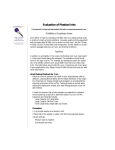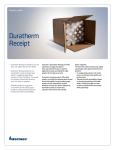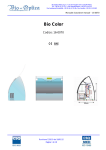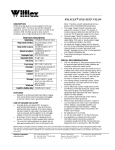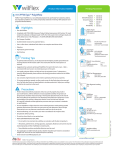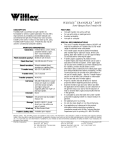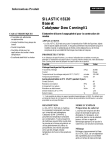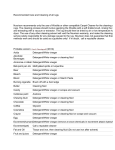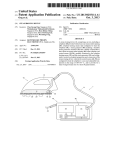Download Evaluation of Plastisol Inks - Stanleys Sign & Screen Supply Ltd
Transcript
Evaluation of Plastisol Inks It is important to always pre-test plastisol inks before commencing production runs. Printability or Processing in Screen Every effort is made to manufacture Wilflex inks to be easily printed under a variety of screen printing conditions. However, quality printing equipment and processes allow Wilflex inks to perform at their best. See the “Screen Printing” section of the Wilflex User’s Manual for further details on screen tension, squeegee selection, art work and printing conditions. Final Print In addition to printability in the screen, the finished print must meet specific criteria and should always be evaluated. The evaluation should be tailored to the type of print. For example, the testing procedure for evaluation of an athletic uniform print would differ from that of an infant wear print. The tests below are provided for your convenience and cover general print applications only. Please contact Wilflex Technical Services for additional information. Wash Testing Plastisols for Cure Failure to cure ink properly can result in poor wash fastness, inferior adhesion, unacceptable durability and increased likelihood of dye migration. Maximum ink tensile strength and elongation is accomplished by ensuring total fusion of the ink film. Testing procedures include wash testing and testing with solvent, with wash testing being the more reliable method. A wash test ensures that printed samples are subjected to standard home laundering practices to determine state of cure on ink film. Apparatus and materials include: Large Capacity 21.7 gal Washer Large Capacity 240 Volt Dryer Three Large heavy weight bath size towels. Procedure 1. Cut printed sample to be tested in half. 2. Place half of the sample in washer with the three large bath towels. 3.Wash settings: Medium load 16.7 gallons Hot Wash/Cold Rinse Normal /Reg. @ 10 minutes 90ml of concentrated detergent 4.After washing is complete, place sample and towels into the dryer. 5. Dryer Settings: Cotton / High (105°F/40°C) / Timed Dry 30 minutes 6. Perform two to five complete wash and dry cycles. 7. Compare washed half of sample with unwashed portion. Evaluation and Classification Failure The ink film is not cured when: 1. Severe cracking of the ink is noted. 2. Partial or total loss of the ink film from the garment. Pass The ink is cured if none of the above is seen. Slight loss of color intensity (AATCC Gray Scale for evaluating change in color 4-5), and slight nap show through are normal for cured ink films after washing. Solvent Cure Test Solvent testing is only the second most reliable method for testing plastisol cure. The most reliable method is wash testing. If solvent testing is chosen to evaluate cure, follow these steps: Method #1: 1. Apply two or three drops of 99 percent ethyl acetate to the surface of the ink layer being tested. Warning! Ethyl acetate is poisonous and flammable. Always wear butyl or nitrile (not latex) rubber gloves and goggles when handling this chemical. Do not pour directly from the container onto the fabric. Use a glass eyedropper. 2. Fold the T-shirt so that the area of the ink film that has been treated with the solvent is pressed against an unprinted area of the T-shirt. 3. Firmly press the two layers of fabric together with a small C-clamp or similar clamping device for two minutes. If any ink transfers from the printed area to the unprinted area, it is an indication that the ink film is not completely cured. Method #1 may give false positive results (the test indicates that the ink is completely cured but it is not) if the ink layer is extremely thick. If the ink layer is thick, use Method #2 when testing with solvent. Method #2: Use for Thick Ink Film 1. Apply two or three drops of solvent to the fabric on the inside of the T-shirt, behind a printed area. 2. Fold the shirt so that you can press the ink layer that has been treated with the solvent against an unprinted area of the shirt. 3. Firmly press the two layers of fabric together with a small C-clamp or similar clamping device for two minutes. If any ink transfers from the printed area to the unprinted area, the ink film may not be completely cured. The ethyl acetate test is described in more detail in “The Solvent Test For Cure” in the April 1995 issue of Screenplay.This article is available as a reprint through ST Publications Inc. Bleed Test Since dye lot variation is very common, it is imperative to test a garment’s propensity for dye migration. Historically, fabrics containing polyester are more likely to bleed than any other fabrics whereas nylon and cotton much less likely to bleed. However, it is suggested that all dark fabrics that will be printed with white or light colored inks should be evaluated for bleeding. The bleeding phenomena occurs due to a reaction between the ink and the dyes of the fabric.The following is a test method evaluating the bleed potential of ink printed on a given fabric: 1. Bleed resistance (or the resistance of an ink to accept the dyes from polyester fabric) is determined by the chemistry of the ink, complete ink cure and by the ink deposit. Choose the screen mesh that duplicates the planned use of the white ink as well as two other possible combinations. 2. Print just the white ink on appropriate fabric swatches and hold for three weeks. After three weeks, visually evaluate the prints for whiteness. (You may choose to try accelerating this evaluation by holding the prints at 105 F/ 40 C for 2 to 5 days.) Additional information on synthetic polyester dye migration and sublimation is detailed in the Screen printing and Graphic Imaging Association (SGIA) Technical Guidebook. Fabric Discoloration Test It is extremely important to pre-test on light colored or stone washed garments. Avoid stacking hot, because such colors are more prone to color distortion due to the dye stuffs inherent in the garment. Fabric and dye characteristics can exhibit variance between manufacturers and from dye lot to lot. The following test will determine if the fabric dyestuffs are prone to discolor: 1. Print ink onto suspect fabric and fuse. 2. Cover the print area with a piece of the suspect fabric (sandwiching the print) and set in a heat press. 3. Set the heat press to 200 F and 5 PSI. 4. Close the transfer press and let sit for four hours before visual evaluation. If material is prone to discoloration, you will see a “ghost”image of your printed image on the material that was covering the printed area. Transfer Release Test It is important to conduct accelerated age tests in your plant, which will indicate how a transfer will release from the transfer paper after six months to one year “on the shelf.” Accelerated aging tests can be performed by placing the printed transfer in a hot box or hot room, at 100 hours at a temperature of 120 F. This will simulate one year of shelf life. Tests conducted in your plant will help keep your transfer/garment reject risk to a minimum. Call PolyOne Tech Services for more information on pre-test procedures 1-800-735-4353





